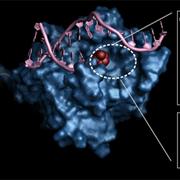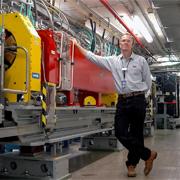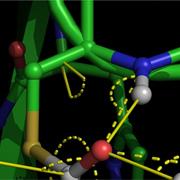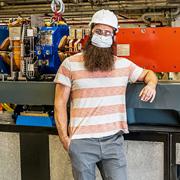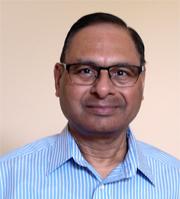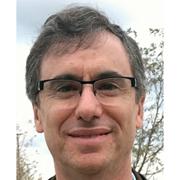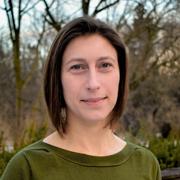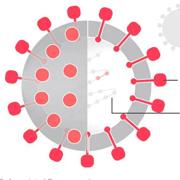News Feed - APS/User News
The 2021 "Gopal K. Shenoy Award for Excellence in Beamline Science at the Advanced Photon Source" (APS) has been awarded to Jiyong Zhao, a physicist in the X-ray Science Division Inelastic X-ray and Nuclear Resonant Scattering Group at the U.S. Department of Energy’s APS at Argonne National Laboratory.
Tim Graber, who spent his entire professional career at Argonne, most recently with the Advanced Photon Source Upgrade Project, passed away on Thursday, April 29, 2021.
Exploring and manipulating the behavior of polar vortices in material may lead to new technology for faster data transfer and storage. Researchers used the Advanced Photon Source at Argonne and the Linac Coherent Light Source at SLAC to learn more.
Scott Williams, deputy chief of the National Institute of Environmental Health Sciences Genome Integrity and Structural Biology Laboratory, received the Southeast Regional Collaborative Access Team Outstanding Science Award.
Glenn Decker started his career at Argonne National Laboratory in May of 1990. One month later, the lab broke ground on the construction of the Advanced Photon Source (APS), which would become a DOE Office of Science User Facility at Argonne offering X-ray science resources to more than 5,500 scientists each year. As a member of the APS team, Decker got to help bring the original APS to life.
The Advanced Photon Source will be holding an online workshop on “Capabilities and Opportunities at the APS Coherent High-Energy X-ray (CHEX) Sector” from 8:45 A.M. to 12:00 noon CDT on Friday, April 30, 2021.
This workshop will consist of several invited talks that will provide an overview of the APS Upgrade, describe the design and characteristics of the CHEX Sector, and provide several examples of the types of science that it is envisioned will be enabled at CHEX.
This workshop will consist of several invited talks that will provide an overview of the APS Upgrade, describe the design and characteristics of the CHEX Sector, and provide several examples of the types of science that it is envisioned will be enabled at CHEX.
Researchers using the APS to examine the atomic structure of SARS-CoV-2, the virus that causes COVID-19, have made a landmark discovery that could contribute critical information to the design of safe and effective antiviral drugs in the fight against the virus.
The Advanced Photon Source Users Organization (APSUO) announces that Mark Rivers and Stephen Sutton are the winners of the 2021 APSUO Arthur H. Compton Award, which recognizes an important scientific or technical accomplishment at the Advanced Photon Source.
Three scientists who use the U.S. Department of Energy’s Advanced Photon Source at Argonne National Laboratory are recipients of prestigious Protein Society of America awards for 2021.
Erica Ollmann Saphire, a long-time user of the U.S. Department of Energy’s Advanced Photon Source, has been appointed President and CEO of La Jolla Institute for Immunology. Dr. Saphire will become La Jolla Institute’s fifth president when she formally begins her term on September 1, 2021.
The U.S. Department of Energy-supported digital twin program will allow researchers to try out their experiments in a simulated version of scientific facilities, before ever setting foot in the real thing.
Jeremy Nudell has always enjoyed taking things apart and putting them back together. So it’s hard to imagine a more fitting job for him than the one he has: Nudell is a mechanical engineering specialist, helping to design and build a comprehensive upgrade to the Advanced Photon Source.
When it’s completed, the upgraded Advanced Photon Source storage ring will include 1,320 new magnets, each one up to five times stronger and much more precise than the ones currently in use, to focus and steer its electron beam. And Animesh Jain will have inspected every one of them.
Research at the U.S. Department of Energy’s Advanced Photon Source at Argonne National Laboratory has zeroed in on several molecules that could be used to create drugs to fight COVID-19.
Daniel Haskel, a senior physicist and group leader with the U.S. Department of Energy’s Advanced Photon Source at Argonne National Laboratory, is one of the 151 Outstanding Referees selected by the American Physical Society for 2021 who “…have demonstrated exceptional work in the assessment of manuscripts published in the Physical Review journals.”
Elina Kasman of the APS X-ray Science Division is a participant in the second cohort of PSE Next Generation of Leaders (NextGen Leaders), which provides the next generation of leaders with the tools and skills needed to coordinate research activities across Argonne’s multidisciplinary directorates and to build strategic programs.
A Wayne State University research team is collaborating with investigators from the Biophysics Collaborative Access Team at the U.S. Department of Energy’s Advanced Photon Source at Argonne National Laboratory and the Illinois Institute of Technology. The combined expertise of Bio-CAT and Wayne State U. will allow the team will use -ray diffraction to study how myosin changes position when living and beating heart muscles move.
Stephen Streiffer, deputy laboratory director for Science and Technology as well as interim associate laboratory director for Photon Services and interim director of the Advanced Photon Source, was 1 of a group of 5 recognized as part of the National Virtual Biotechnology Laboratory Team, which received a Secretary of Energy’s Achievement Award, for its pivotal role in supporting the national response to COVID-19.
With a powerful enough light, you can see things that people once thought would be impossible. A project that brought scientists at three U.S. Department of Energy national laboratories together has achieved an important milestone that has been in the works for more than 15 years: They have designed, built and fully tested a new state-of-the-art half-meter-long prototype magnet that meets the requirements for use in existing and future light source facilities.
On January 11, 2021, Argonne National Laboratory Deputy Laboratory Director for Science and Technology and Interim APS Director Stephen Streiffer joined John Williams to explain how our understanding and response to COVID-19 has moved forward so quickly, at the one-year anniversary of the SARS-CoV-2 genome release. And he shares insight into new strains of the coronavirus.




